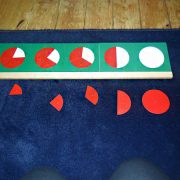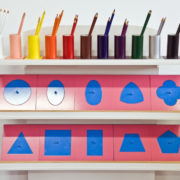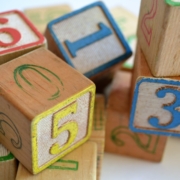Mathematics: Addition Strip Board
Use of the Addition Strip Board requires children to have a good grasp of quantity to numeral because the equations (or addition sums, in a non-Montessori context) that are taught in this exercise are quite abstract. Little ones who have not yet mastered concepts in the Number Beads or Teen Board activities might struggle with the Strip Board, so make sure the child in question is really ready to progress, so as to avoid unnecessary frustration.

The exercise includes a board, which is divided into squares (usually 18 across and 11 down) and two sets of strips; one set is blue, with symbols 1-9, and the other is red, also with symbols 1-9. The end square of each strip is marked with the symbol that corresponds to the number of its squares.
Before starting, place the board on a flat surface and the red and blue strips on either the left or right of the board, in order. Then, place strips on the board according to the instructions of each equation (3+4, 9+7, 6+4 etc.) thus indicating the correct answer, which can also be reinforced by counting the squares. One the equation has been completed, place the strips back in order and start a new equation. See the below tutorial by My Montessori Works for the exercise in action:
The idea behind this activity, other than to teach basic mathematics in an easy-to-understand format, is to explore numbers in a way that’s both exciting and intriguing; the last thing you’d want to do is force the issue. There are three ways to ensure that this does not happen:
- Make sure the child is ready (as already stated).
- Set up the exercise correctly – in an orderly, efficient manner, which will curb any potential annoyance if concepts are difficult at first attempt.
- Do as many (or few) equations as the child shows interest.
If you’d like further information about this tutorial, feel free to contact us at info@saintandrewsmontessori.com. We’re happy to answer any questions.















